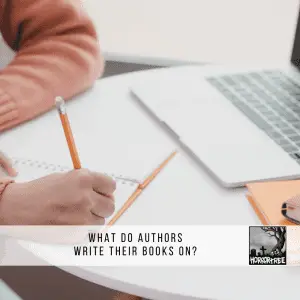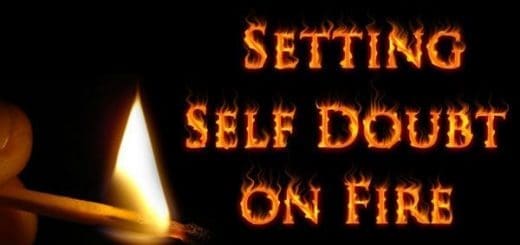What do authors write their books on?
What do authors write their books on?
By Lauren McMenemy
 There’s plenty of advice out there from the biggest and most successful writers in the world, but they’ve got time, experience, help and money on their side. What about the millions and millions of people out there writing every day, for pleasure, for work, for therapy, for reasons only they know and probably don’t interrogate. What do the world’s writers use to capture their words and thoughts? What do authors write their books on?
There’s plenty of advice out there from the biggest and most successful writers in the world, but they’ve got time, experience, help and money on their side. What about the millions and millions of people out there writing every day, for pleasure, for work, for therapy, for reasons only they know and probably don’t interrogate. What do the world’s writers use to capture their words and thoughts? What do authors write their books on?
Of course, we turned to social media for this one. Posting a plea on three platforms – Twitter, Instagram, and Mastodon – we received a variety of responses. Naturally, there are two main camps: those who prefer the tried and tested ancient process of pen on paper, and those who need to quickly type their words into technology (computer, tablet, typewriter) before they lose their train of thought. But within those two camps are whole worlds of differences.
A Twitter poll came out overwhelmingly in favour of technology: just 17.8% of respondents opted for pen and paper; 75.6% chose computer or laptop, with the rest using either a tablet or other writing technology. But there were only 45 votes, so take from these results what you will.
“I’m mostly word processor,” said Vicky Brewster (@VProofreader). “Sometimes if I know it’s a short story I hand write first then type up.”
Venezuelan writer AJ Marquez (@ajmarquez) said: “It’s tricky. But I’ve found that most of the times pen and paper are great for a first draft and then the computer. But it also depends if I wrote at home or from a train/flight. Then computer.”
Sometimes, technology is an enabler; John Evans (@roninmercllc) responded: “I use Openoffice on my laptop as old injuries make holding and using a pen/pencil for more than 10 or 15 minutes painful.” And Stephen McGowan (@GeekDaddyPrime) writes: “I use an iPad if I’m taking something out of the house. Even with the Bluetooth keyboard it’s lighter than a laptop and I can access my work related apps on it (chillsubs, upwork, fiverr, LinkedIn etc). It’s not great for formatting though so I finish things off on a laptop.”
Authors write using a variety of platforms, formats and processes
The nature of the other platforms – Instagram and Mastodon – allowed our respondents to wax a little more lyrical about their writing process and what each author uses to write their books.
Canadian writer Abra Hanen responded via Instagram with an insight into the writerly obsession with pens and apps: “Fountain pens with assorted ink colours and non-bleed paper. Typewriters and repurposed papers. Index cards and cheap notebooks and sticky notes and backs of envelopes, usually with purple Uni-ball Signos because purple is my default and the retractable pens mean no caps to lose. Laptop (mostly with OpenOffice for shorter projects and drafts, Scrivener for novels, scripts, and collections of poetry and essays, WorkFlowy for lists, notes, and outline-based drafting, Google Docs for collaborations). Phone with apps especially WriterP in dark theme, and voice recognition software in various forms. So much depends on whether I’m note-taking or composing first drafts or reworking or doing line edits, what size of project I’m working on (drabble vs novel, for example), whether I have screen-fatigue, and where I am physically (indoors vs outdoors, public vs private, desk vs sofa…) and mentally (needing stimulation, needing zero distraction, etc). And earphones – whether I’m blocking out street noise or wrapping my brain in a playlist I’m using as a project soundtrack, it’s rare for me to write without some kind of sound buffer.”
Lucie Goulet, a French fantasy writer (@lucie_marieg on Instagram), told me: “I use Word on my existing laptop. I considered downloading Scrivener or something but I also figured that for the first draft of my first manuscript, I didn’t need more reasons to procrastinate, which I would likely do with a new software. I think I will download it for when I’m editing though. And then I use post-it notes to do reminders for myself and do some light story mapping.”
Blogger and journaler Beth Nascè (@mystical_drifter on Instagram) uses a combination of formats and processes: “Handwriting often gets the general ideas out and lets me test nice turns of phrase etc. Laptop/Google Docs is often where the story actually happens and I try to just write the whole thing, leave it for a day then come back and edit it. Then when I’m feeling particularly extra and artistic I use a typewriter and write weird vignettes or poetic pieces.”
Writing with a pen connects hand to heart
Form of writing definitely seems to have an impact on the choice of implement. When the writing involves more contemplative thinking, such as journaling or morning pages, many writers prefer the connection of heart and hand that handwriting brings; when it’s a flurry of first drafting or laborious editing, it seems to be a computer kinda thing. Many writers use a combination of both, depending on what they’re working on.
“I don’t know why, but journaling is just better handwritten,” responded Bethany Carter (@[email protected]) on Mastodon. “I get more into my inner stuff than if I type, or something like that.”
And those who choose pen and paper can be VERY picky. When I asked #writersofmastodon their views, I received some passionate pledges for fountain pens, uni-ball pens, even very specific ink colours.
New Zealand-based author of fantasy Deb E. Howell (@[email protected] on Mastodon) responded: “I tend to go with typing, these days. But, if I can really carve out the time and space, I LOVE handwriting, and I tend to use a tablet/stylus for a few reasons: I’ve yet to find the perfect pen. So few write super smoothly. And those that do are invariably black or blue ink… no purple. And even then, they usually start dropping extra bits of ink in the middle of words eventually… yuck. I’ve had a nice fountain pen/paper combo, but it was in a notebook that was quite thick, so it became uncomfortable. And often there is friction between the paper and pen that wears out my hand. A nice Samsung tablet with a soft, brush-tip stylus is super smooth and I can write in purple “ink” in OneNote… But I rarely step fully away from my computer enough to really get into the handwriting flow. I need to carve out that time and space because I love it when I do. And my writing comes out better when I’ve handwritten. The words are just better, slightly more poetic.”
Then there are those who would “love” to be handwriters, but the pesky task of transcribing that to the computer has driven them away. “I would love to just write longhand in notebooks, but the transcribing to digital proved too time-consuming,” said Harlem Slim (@[email protected] on Mastodon). “When I first started writing, I had SIXTY handwritten – college-ruled – pages. Took me a week! I used to write on a laptop comfortably reclining, but my eyesight got so bad I now have to use a bigass monitor to see what I’m doing. Two bigass monitors, in fact.”
Meanwhile Canadian speculative writer E. Rose Hamilton (@[email protected] on Mastodon) responded: “Originally, I preferred handwriting. There’s a connection between thoughts and the physicality of writing that feels immediate, natural. Typing (keyboard, computer) is efficient and faster though some of the intimacy is lost, if I can say it that way. The laptop feels restrictive but I can use it out of necessity. For personal writing and when I need to get to the creative heart of a draft, I take up a pen. Uniball is my decades-long choice for written words.”
Technology as a writerly enabler
We also had a big hands-up for Microsoft Word’s Read Aloud feature for catching issues in the writing, and many, many writers who use either Scrivener or Google Docs for their drafting. Some use speech-to-text technology such as audio notes on their phone while going for a walk. Other technologies mentioned included the reMarkable, tablets like iPads, and some brave creators even used their smartphones to draft books!
“Google Docs on my phone,” says André Spiteri (@[email protected] on Mastodon). “I find it’s much less pressure than sitting in front of my laptop, especially during the tricky first few thousand words where I’m still flailing about. I’ll need to use my laptop for the second draft though, I think. I don’t see how I can rewrite on my phone. It was probably terrible for my eyesight but I doubt I’d have finished a first draft if I hadn’t used my phone.”
But, again, it seems most authors write their books on a mixture of things and in a mixture of ways. As Breanne Boland (@[email protected] on Mastodon) said: “Handwriting for journaling, always – I can type as fast as I think, but I can’t write that fast, and this is key. Google Docs for most drafting/outlining purposes, with a step at the start of every revision to print out, write on, and post-up up the printed manuscript. The hard shift seems to be important! But then everything gets transcribed back into Google Docs.”
So there you have it: there doesn’t seem to be a one size fits all for what authors write their books on – but then, every author’s process is unique to them. The main thing is to experiment, see what feels right to you – you’ll know it when you do it! – and keep at it. There will always be new technologies appearing in our feeds, but don’t allow experimenting with a new format or process to distract you from your main goal: getting the writing done. As we’ve seen, all you really need is a pen and some paper…
- About the Author
- Latest Posts
Lauren McMenemy wears many hats: Editor-in-Chief at Trembling With Fear for horrortree.com; PR and marketing for the British Fantasy Society; founder of the Society of Ink Slingers; curator of the Writing the Occult virtual events; writers hour host at London Writers Salon. With 25+ years as a professional writer across journalism, marketing, and communications, Lauren also works as a coach and mentor to writers looking to achieve goals, get accountability, or get support with their marketing efforts. She writes gothic and folk horror stories for her own amusement, and is currently working on a novel set in the world of the Victorian occult. You’ll find Lauren haunting south London, where she lives with her Doctor Who-obsessed husband, the ghost of their aged black house rabbit, and the entity that lives in the walls.













